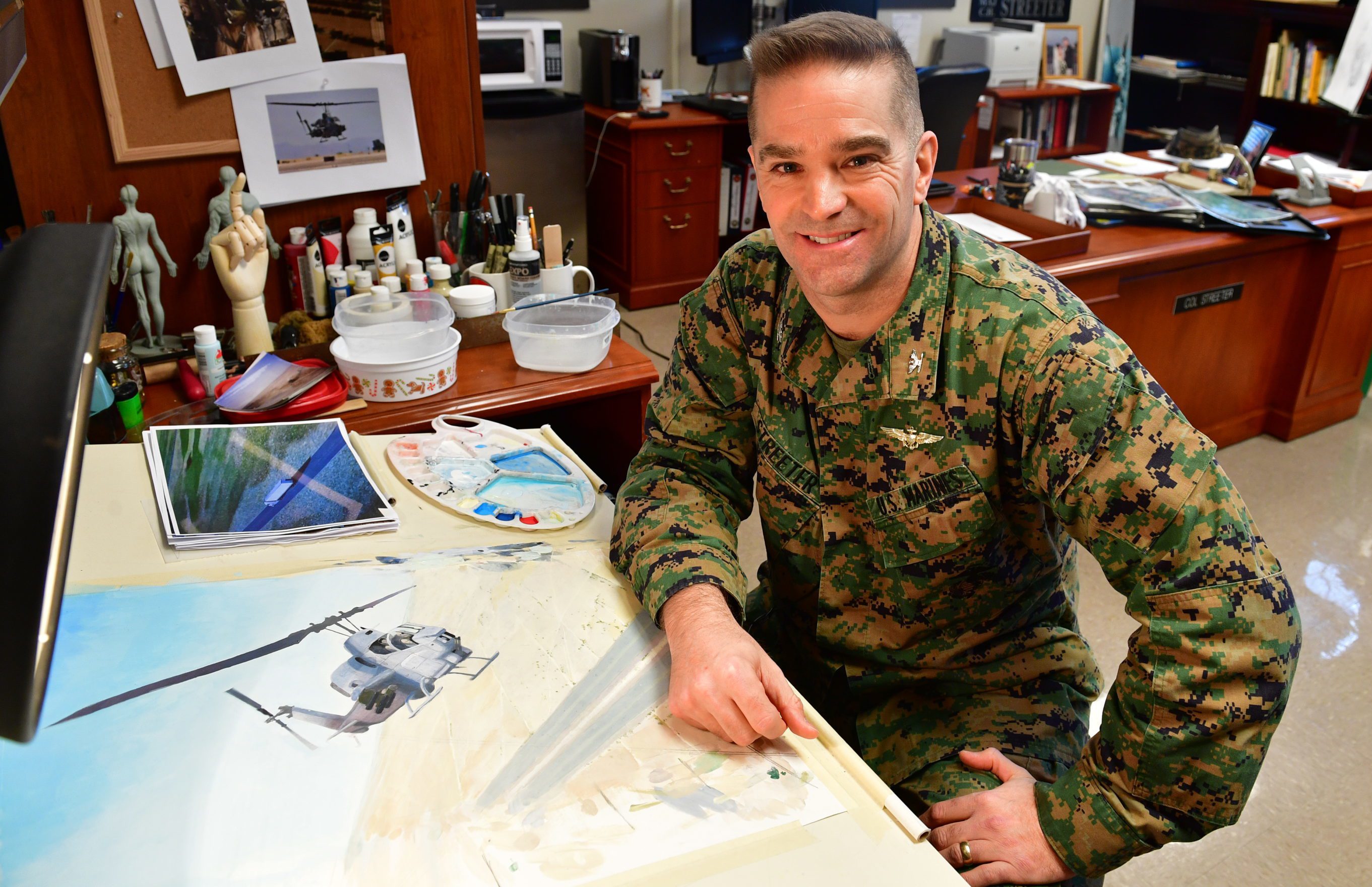Streeter ’91 Depicts Battlefield Experience

Col. Craig Streeter ’91 in his office studio, where he does much of his drawing and painting. VMI photo by Kelly Nye.

Col. Craig Streeter ’91 in his office studio, where he does much of his drawing and painting. VMI photo by Kelly Nye.
Growing up, all Col. Craig Streeter ’91 wanted to do was draw – and follow his Army officer father into a military career. Little did he know when he was a youngster happily settled at the kitchen table with paper and crayons that he not only would do both, but that he would succeed at both in spades.
Streeter, who’s currently the head of Naval ROTC at VMI, is one of a handful of combat artists in the Marine Corps. Like courtroom artists, combat artists sketch scenes of what’s going on in front of them – only the images they create show the reality of the battlefield. Their work complements that of photographers, both civilian and service affiliated.
“There’s room for both [illustrators and photographers],” noted Streeter. “What illustration can do and combat art can do, the artist has the freedom to take many experiences and distill them down into one powerful image that tells the story in ways that photography just can’t. That’s just one of many things that makes it powerful.”
When he matriculated at VMI, Streeter didn’t even know the combat artist program existed. He drew plentifully while at the Institute, sketching barracks life for the amusement of his brother rats, but art was always a side pursuit. He graduated with a degree in history and commissioned into the Marine Corps, lured by a love of flying, and soon found himself on the usual career military path of frequent moves and regular promotions.
Even while he was flying Cobras, though, Streeter was finding outlets for his artistic skills.
“I would seek opportunities to use my art in ways that would benefit the unit,” said Streeter. Creating new squadron patches and designing logos for the Marine Corps birthday ball were among his side jobs. When he was stationed at the Marine Corps Air Station New River as a captain, he began drawing a regular comic strip for the base newspaper.
“The feedback I got from that was addictive,” Streeter commented. “People seemed to like it and enjoy it. It just made me want to do it more and more.”
Later, while stationed at the Pentagon, Streeter found himself charged with the task of creating one-of-a-kind farewell gifts for retiring generals and admirals. He was a busy man.
“It got to the point where my boss, who was a Marine colonel, would tell me to take time off,” Streeter recalled. “He’d say, ‘Don’t come in. The general needs his farewell gift.’”
It was at this point that Streeter’s wife, Chris-Ann, found an article in Seapower, a magazine for those in the naval services, that would change her husband’s life. It was about combat artists Mike Fay, then a chief warrant officer, and Chris Battles, then a staff sergeant, and their work as combat artists deployed alongside troops in Afghanistan and Iraq.
Fascinated, Streeter remembers thinking immediately, “I’ve got to meet those people.” Soon, he and Fay were meeting for coffee, with Streeter immediately asking how he could become a combat artist.
“Mike [Fay] couldn’t guarantee that would ever happen,” said Streeter. “It’s just not something that a major in the Marine Corps does. It’s a very small [military occupational specialty] that’s definitely not a primary MOS.”
That initial meeting between Fay and Streeter took place in late 2006 or early 2007. For Streeter, all that happened next was that life moved on. He was promoted to lieutenant colonel and then colonel.
“I almost forgot about the dream of being a combat artist somehow,” Streeter related. “I thought the whole combat artist thing had just passed me by.”
As a newly minted colonel, Streeter was stationed at Quantico, home of the National Museum of the Marine Corps – the organization that just happens to run the combat artist program. Once again, Chris-Ann Streeter stepped into action, asking her husband, “Have you talked to Mike [Fay]? Have you swung by the museum?”
When he did so, Craig Streeter discovered that both Fay and Battles had left the Marine Corps, leaving the service with no combat artists. What happened next was Streeter asking those higher in the chain of command if he could become one. Each time, the senior officer said “yes” because he already knew Streeter as a person and a pilot.
In the summer of 2014, the career Marine Corps officer’s dream came true as he received orders to go to Afghanistan as a combat artist that September.
“I had a blast,” said Streeter. “One day I was with infantry and I’d go on patrols. The next day I’d be with the aviation elements and I’d be in the back of a Huey. … Being a colonel, I felt like I had the red carpet rolled out wherever I went. I couldn’t be happier.”
All too soon, his time was up – but the art that Streeter was able to create made the pain of leaving more bearable. One graphite and water color painting of his, “Friendly Fires,” hung in the National Museum of the Marine Corps for over a year.
“To have been able to work myself into the system, and to be rewarded by the fact that someone thought something I’d created was good enough to hang in the NMMC, for me was that was the best thing I could imagine for my art,” he commented.
Asked about what lies on the horizon, Streeter expressed his desire to use his talents at the Institute.
“I’m just hopeful that I can keep doing this not only for the Marine Corps but also for VMI,” said Streeter. “If someone offers me an opportunity to go into the field and do art alongside VMI cadets, I would jump at the opportunity.”